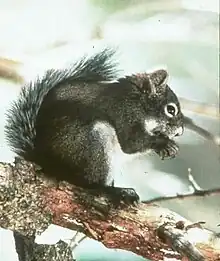Southwestern red squirrel
The southwestern red squirrel or Fremont's squirrel (Tamiasciurus fremonti) is a species of tree squirrel endemic to high-altitude regions of the southwestern United States.
| Southwestern red squirrel | |
|---|---|
 | |
| Mount Graham subspecies of southwestern red squirrel | |
| Scientific classification | |
| Domain: | Eukaryota |
| Kingdom: | Animalia |
| Phylum: | Chordata |
| Class: | Mammalia |
| Order: | Rodentia |
| Family: | Sciuridae |
| Genus: | Tamiasciurus |
| Species: | T. fremonti |
| Binomial name | |
| Tamiasciurus fremonti | |
| Subspecies | |
|
T. f. grahamensis | |
| Synonyms | |
|
Tamiasciurus hudsonicus fremonti | |
Taxonomy
It was formerly considered conspecific with the American red squirrel (T. hudsonicus), but a 2016 study found sufficient phylogenetic evidence indicating it was a distinct species.[2] The American Society of Mammalogists accepted the results of this study.[3]
The Mount Graham red squirrel (T. f. grahamensis) is a notable, endangered subspecies of the southwestern red squirrel. In addition, genetic sampling indicates that squirrels from the Sacramento Mountains of New Mexico form a highly divergent clade that dates back to the Last Glacial Maximum, about 130,000 years ago. Squirrels in the San Mateo Mountains also appear to be genetically divergent, although this is only based on a single individual.[2]
Distribution
It ranges from the Rocky Mountains of southern Colorado into the Sacramento Mountains in New Mexico and the Mogollon Mountains in both New Mexico and Arizona. Its range overlaps with that of T. hudsonicus in the southern Rocky Mountains.[2][4]
Habitat
They largely inhabit mixed coniferous and spruce-fir forests. Although they occasionally venture down into ponderosa pine forests, they are absent from ranges that do not include the higher-elevation spruce-fir and mixed coniferous forests. Due to the limited range of this habitat, the population of southwestern red squirrels is naturally fragmented and has little gene flow between subpopulations; these populations may have been more widespread during the last glaciation, when these forests were more connected. Fossil remains of this species are known from the Guadalupe Mountains, indicating that they likely once had a suitable climate.[2][5]
Conservation
There is little evidence of demographic-driven expansion in populations of this species, and mountain ranges each have their own highly-divergent clades of species, indicating high separation and little gene flow between populations. If this lack of connectivity is compounded with further degradation of their habitats, the population dynamics of this species could eventually be driven by extinction. Thus, this species is thought to be of high conservation concern. One notable subspecies, the Mount Graham red squirrel, is already thought to be endangered.[2]
References
- "NatureServe Explorer 2.0". explorer.natureserve.org. Retrieved 7 October 2022.
- Hope, Andrew G.; Malaney, Jason L.; Bell, Kayce C.; Salazar-Miralles, Fernando; Chavez, Andreas S.; Barber, Brian R.; Cook, Joseph A. (2016-07-01). "Revision of widespread red squirrels (genus: Tamiasciurus) highlights the complexity of speciation within North American forests". Molecular Phylogenetics and Evolution. 100: 170–182. doi:10.1016/j.ympev.2016.04.014. ISSN 1055-7903. PMID 27083861.
- "Explore the Database". www.mammaldiversity.org. Retrieved 2021-09-11.
- "NatureServe Explorer 2.0". explorer.natureserve.org. Retrieved 2021-09-11.
- "Tamiasciurus fremonti". www.utep.edu. Retrieved 2021-09-11.
